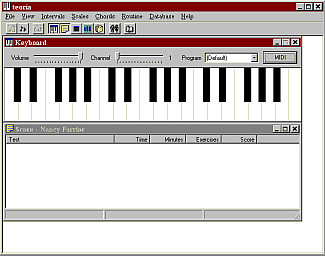|
|||
ometimes you can get too much of a good thing. teorķa presents music theory concepts in great detail; it has a considerable amount of capability for the teacher or student to customize lessons to their particular needs through its Routines feature. However, in this case, there are too many choices available for the first time user, in the absence of better documentation and tools to aid the user in making use of the choices. teorķa is available in the full commercial version that we reviewed and a smaller, downloadable shareware version which is fully functional but lacks some of the features of the commercial version (database and charts, electronic books about intervals, scales and chords, and ability to create and run Routine files).
|
|||
|
teorķa can be intimidating on-screen. There is little color. It is visually uninteresting, especially for younger students. After successfully installing the program, it was not immediately apparent how to integrate the program into a tutorial session. The online Help explains all of the theory topics in the program, but provides no guidelines for usage. An online tutorial with tips for use of teorķa is a noticeably absent feature which would make teorķa less intimidating. I was stumped as to what to do with the program until I explored all the Help topics available and discovered the function of the Routine menu item. The "Routine" option makes the program more usable and customizable. You can create an individualized instruction routine using any of the exercises. This takes time and you must be able to understand musically the choices available. Although they were not included with the commercial
version we reviewed, over 50 pre-written Routines and a Routines "wizard" to aid
in the creation of Routines are available for free download by registered users only from
a secure section of the teorķa Web site (http://www.teoria.com/secure/index.htm).
We downloaded and examined some of these Routines. They are certainly helpful, but
the program still has too many options to make younger students comfortable with going
through the routines. When you run a downloaded Routine, most of which we liked, the
screen provides pre-chosen options to work on, but this is still intimidating to those
unfamiliar with what all the options mean. I would change one additional aspect of the program. In the Scales ear-training option, under melodic dictation, the program counts you as playing the first note, even though you’ve only heard the dictation. I would like to have to enter the first note; it helps you think of the intervals better. teorķa is very thorough in covering music theory concepts. In this case, it's thoroughness is the best and worst part of the program. It has too many customization options; creating customization Routines is time-consuming and harder than it should be. The addition of more graphics and color, though not necessary to teaching the material, would make the program seem more accessible, particularly to younger students. Currently, the program is directed primarily toward teachers and conservatory-level students. teorķa is most useful in a piano studio and to older children and adults because of the difficulty level of the options and the lack of visual interest. My young students did the sections I asked them to do, but they really did not like the way the program looked. I would give a limited recommendation of teorķa to other piano teachers. It would not be one of my primary music lab programs, but would be much more attractive with improvements in ease of use and visual interest. We understand from correspondence with the author, an instructor with the Conservatory of Music of Puerto Rico, that the next version of teorķa will include several of the pre-written routines and, possibly, the Routines wizard. An online tutorial is also under consideration for the next version. We hope that these improvements in user-friendliness can be made so as to release the latent power of teorķa for children and beginning students, in addition to the adults and advanced students that teorķa well serves now. If you're a teacher that likes to choose from a "cafeteria" of music theory exercises so as to individualize each student's instruction or an advanced student needing work on specific areas of music theory, teorķa may be just what you're looking for. teorķa, Version 1.3.1, List price - $32. Available directly from the author: Jose Rodriguez Alvira, Cond Monte Sur, 190 Ave Hostos, Apt. B-342, San Juan, PR 00918-4236. $32.00 (US) per copy, plus $6.00 shipping and handling (US and Canada). WWW: http://www.teoria.com. E-mail : teorķa@teorķa.com. |
||
|
Page
created: 8/29/98 Last updated: 02/02/24 |


 The
commercial version of teorķa comes on four 3½ inch disks that are easily
installed under Windows 95, using the Run option from the Start menu. Most parents and
teachers should be able to get it up and running without problems.The program can be
installed in English or Spanish language versions, a nice option for bilingual students or
studios having students speaking either as a native language.
The
commercial version of teorķa comes on four 3½ inch disks that are easily
installed under Windows 95, using the Run option from the Start menu. Most parents and
teachers should be able to get it up and running without problems.The program can be
installed in English or Spanish language versions, a nice option for bilingual students or
studios having students speaking either as a native language.